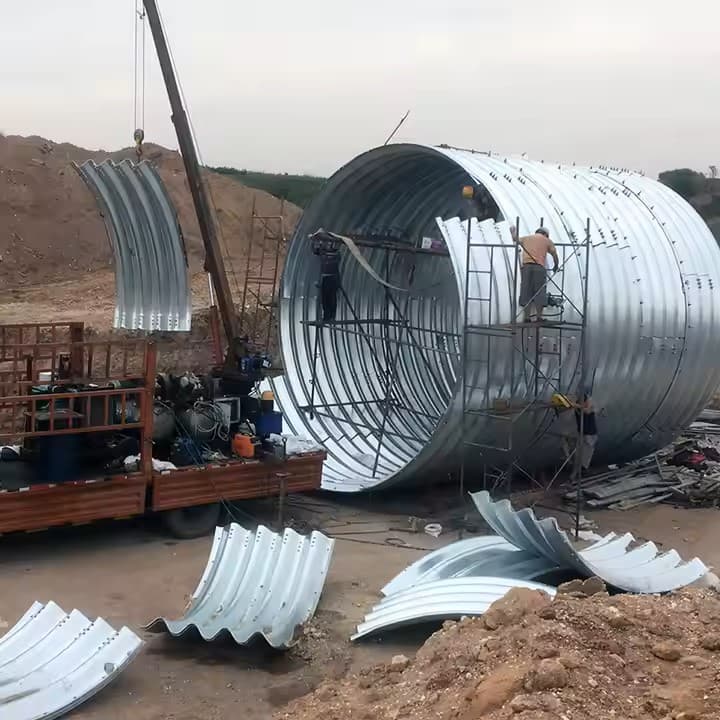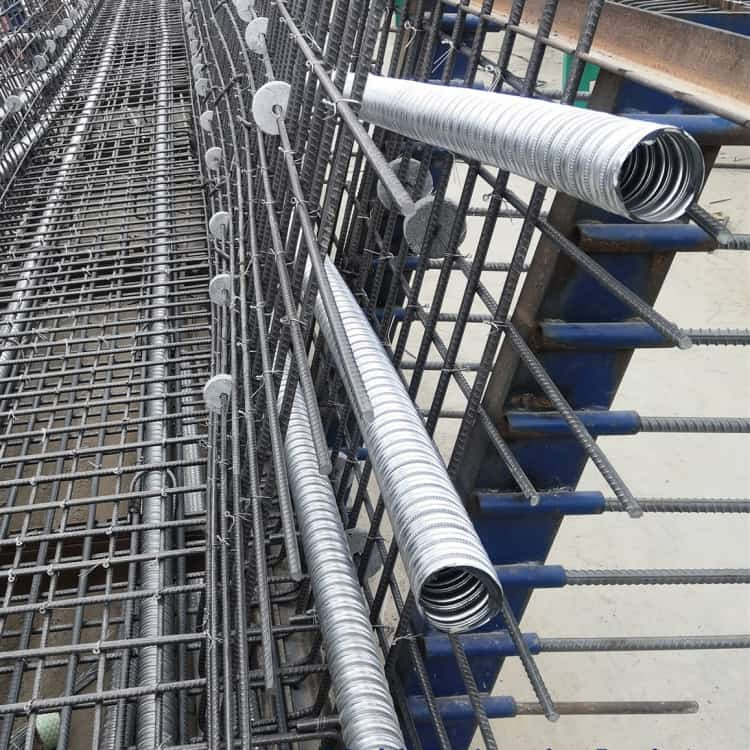Dual Wall Pipe Installation Guide
(Complying with ASTM F2648 & EN 13476 Standards)
I. Construction Sequence
- Survey & Marking → 2. Mechanical Trenching → 3. Subgrade Compaction → 4. Gravel Base Course → 5. Sand Bedding → 6. Pipe Installation → 7. Manhole Construction → 8. Backfilling → 9. Hydrostatic Test → 10. Final Compaction
 II. DWCP Installation Protocol
II. DWCP Installation Protocol
1. Pre-Construction Preparation
- Review design drawings to confirm pipeline layout, slopes, and connection requirements
- Verify existing control points (benchmarks & traverse points) along the alignment
- Conduct topographic survey, plot as-built sketches, and establish temporary control points
2. Trench Excavation
| Parameter | Requirement |
|---|
| Trench Width | Pipe OD + 0.4–1.0m (min. 600mm working space) |
| Slope Ratio | As per design (typically 1:0.33–1:1 for cohesive soils) |
| Undisturbed Soil | Preserve 200–300mm above design grade; trim manually before pipe laying |
| Over-Excavation | Backfill with 10–15mm graded gravel or coarse sand (≥95% compaction) |
| Groundwater Control | Install sump pumps + 100mm gravel drainage layer where required |
3. Pipe Foundation
| Soil Condition | Foundation Specification |
|---|
| Stable Soil | 100mm sand bedding (CBR ≥5%) |
| Waterlogged Soft Soil | 150mm crushed stone (5–40mm) + 50mm sand layer (Total ≥200mm) |
| Organic Soil | 300mm graded Gobi gravel replacement |
4. Pipe Installation
- Jointing Method: Snap-tight couplings with EPDM gaskets (per ASTM D3212)
- Alignment Tolerance: ±10mm vertical/horizontal deviation per 3m length
- Deflection Limit: ≤5% of nominal diameter (post-installation)
5. Quality Control Checks
| Stage | Inspection Items |
|---|
| Pre-Installation | Pipe certification (ISO 9001), ovality (<3%), rubber ring hardness (50–60 IRHD) |
| During Installation | Bedding compaction, joint seating depth, pipe invert elevation (±15mm) |
| Post-Installation | Hydrostatic test (1.5× working pressure for 30min), deflection measurement |
 Dual Wall Pipe Installation Guide
Dual Wall Pipe Installation GuideIII. Critical Technical Requirements
1. Backfilling
- Initial Layer: Select backfill to pipe springline (≤300mm lifts, 90% compaction)
- Final Layer: Native soil in 500mm lifts (≥95% compaction for road sections)
2. Manhole Integration
- Use flexible boot adapters (per ASTM C923) at pipe-manhole connections
- Apply bentonite waterstop at penetration points
3. Testing Protocols
- Mandrel Test: Pass 95% pipe diameter mandrel through installed pipeline
- Leakage Test: Max 1.25 l/km/day for diameters ≤1000mm (per EN 1610)
 Ⅳ. Pipe Installation
Ⅳ. Pipe Installation
1. Handling & Placement
| Method | Specification |
|---|
| Manual Installation | Lift pipe ends to trench workers (max. 3m depth or ≤DN400 pipes) |
| Mechanical Lowering | Use non-metallic slings for >3m depth/DN400+ pipes (metallic tools prohibited) |
| Alignment Tolerance | ±10mm vertical/horizontal deviation per 3m length |
2. Jointing Techniques
- Socket-Spigot Joints: Install with spigot facing downstream (per ISO 8639)
- Spiral Corrugated Joints:
- Methods: Electrofusion, extrusion welding, or heat-shrink sleeves
- Tolerance: Max. 2mm radial misalignment
3. Quality Control
- Cutting: Use fine-tooth saws for square cuts (burr-free)
- Gasket Inspection: Verify O-ring position with feeler gauge (0.5-1.0mm gap)
- Elevation Check: Measure crown elevation every 10m (converted to invert)
Ⅴ. Manhole Connection
1. Connection Methods
| Type | Technical Requirements |
|---|
| Flexible Joint | Pre-installed EPDM boot adapter (min. 100mm overlap) |
| Rigid Connection | M10 cement mortar with 5% calcium sulfoaluminate expansion agent |
| Precast Collar | C15 concrete collar (ID=pipe OD+20mm, thickness≥50mm) + rubber gasket |
Ⅵ. Backfilling Protocol
1. Compaction Requirements
| Zone | Compaction (%) | Material |
|---|
| Pipe Foundation | 85-90 | Washed sand (0.5-2mm) |
| Pipe Haunches (2α zone) | 95 | Graded gravel (5-40mm) |
| Pipe Springline to 0.5m | 90/85* | Select backfill (≤10% fines) |
| Above 0.5m | ≥80 | Native soil |
*Note: 90% for sides, 85% for top
2. Special Conditions
- High Water Table: Install geotextile (200g/m²) + underdrains
- Uneven Settlement: Use flowable fill (CLSM) for transition zones
Ⅶ. Pressure Testing
1. Hydrostatic Test
- Procedure: Fill to 2m head pressure for 24hrs (per GB 50268)
- Allowable Leakage: ≤1.25 L/km/day for DN≤1000mm
2. Alternative Methods
- Air Test: 25kPa for 5min (max. 0.5kPa pressure drop)
Ⅷ. Deformation Inspection
1. Post-Installation Check
- Timeframe: Measure within 12-24hrs after final backfill
- Tolerance: Max. 3.3% diameter deflection (2/3 of allowable)
2. Corrective Actions
- Expose 85% pipe height (manual excavation within 0.5m)
- Replace damaged sections
- Recompact with ASTM D698 compliant material
 II. DWCP Installation Protocol
II. DWCP Installation Protocol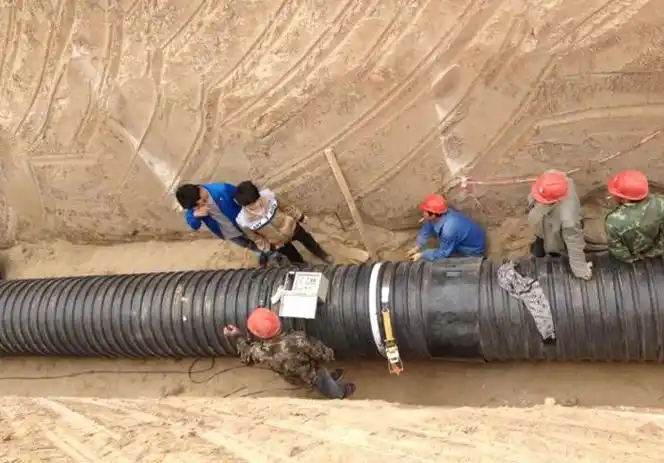
 Ⅳ. Pipe Installation
Ⅳ. Pipe Installation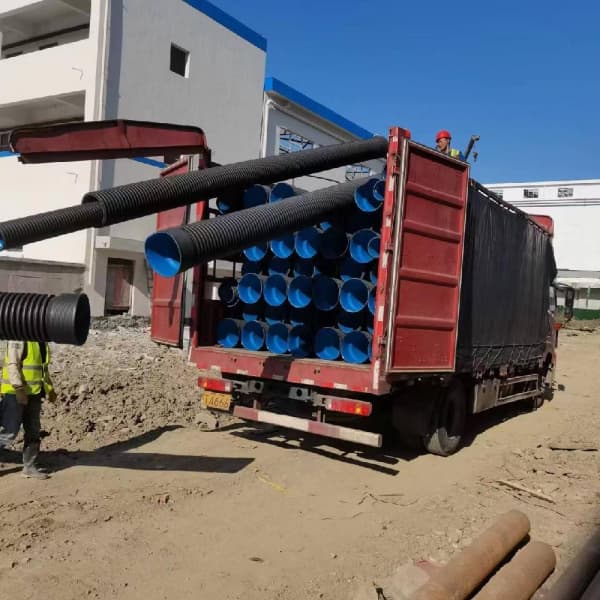 II. DWCP Installation Protocol
II. DWCP Installation Protocol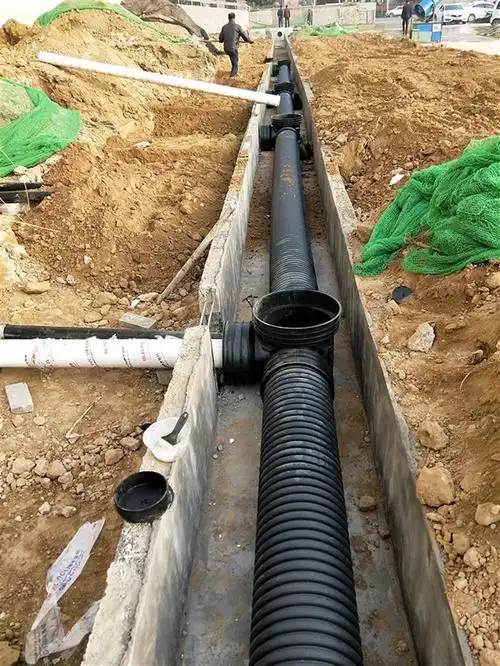 Ⅳ. Pipe Installation
Ⅳ. Pipe Installation